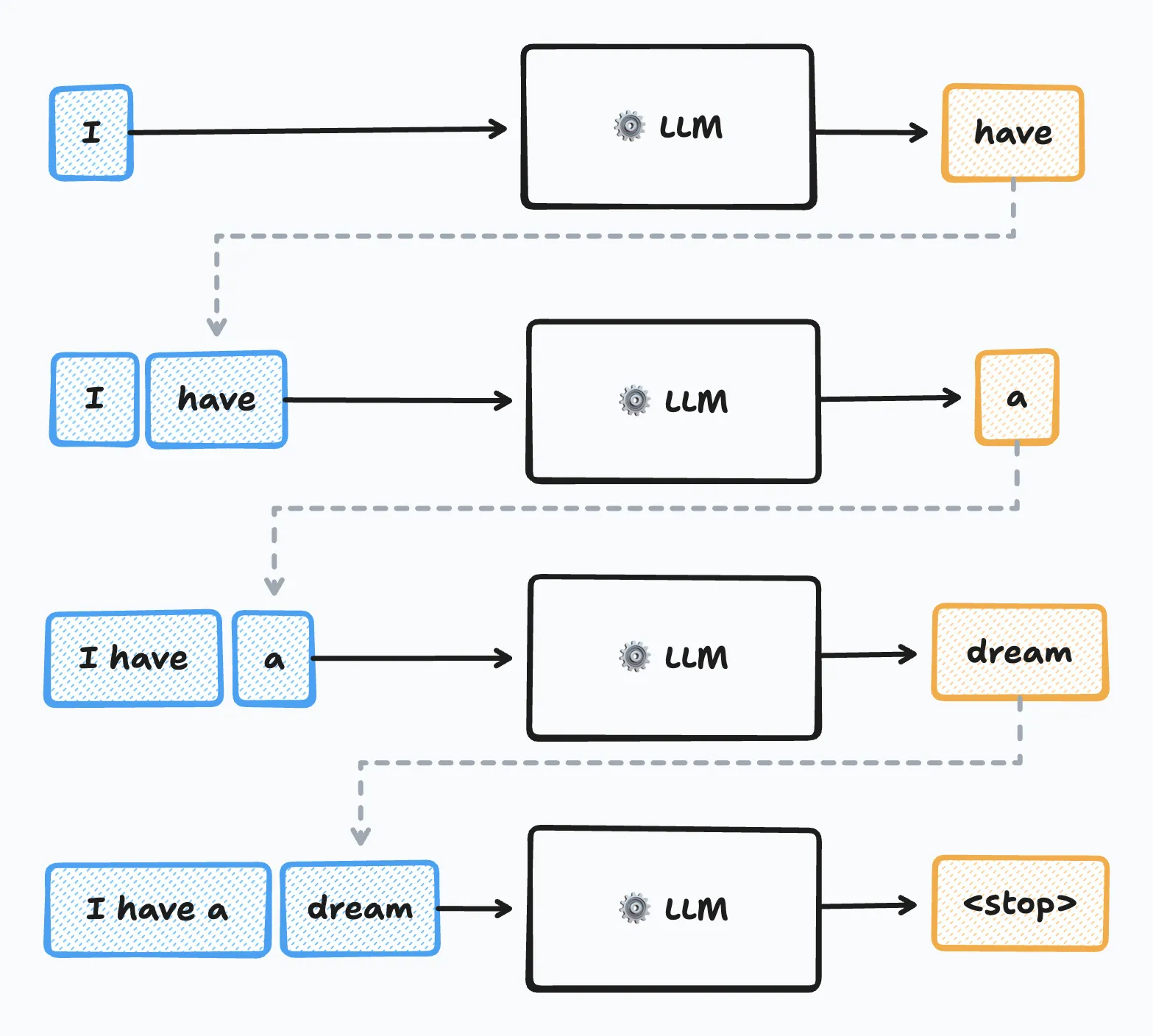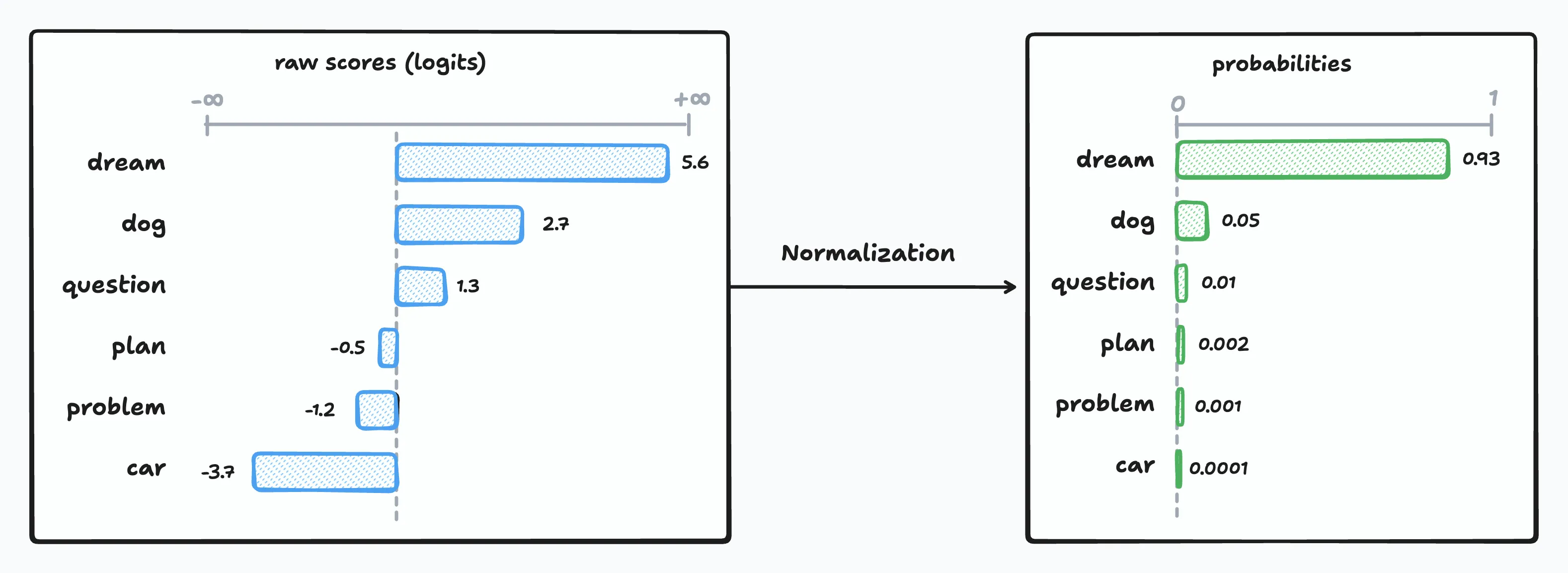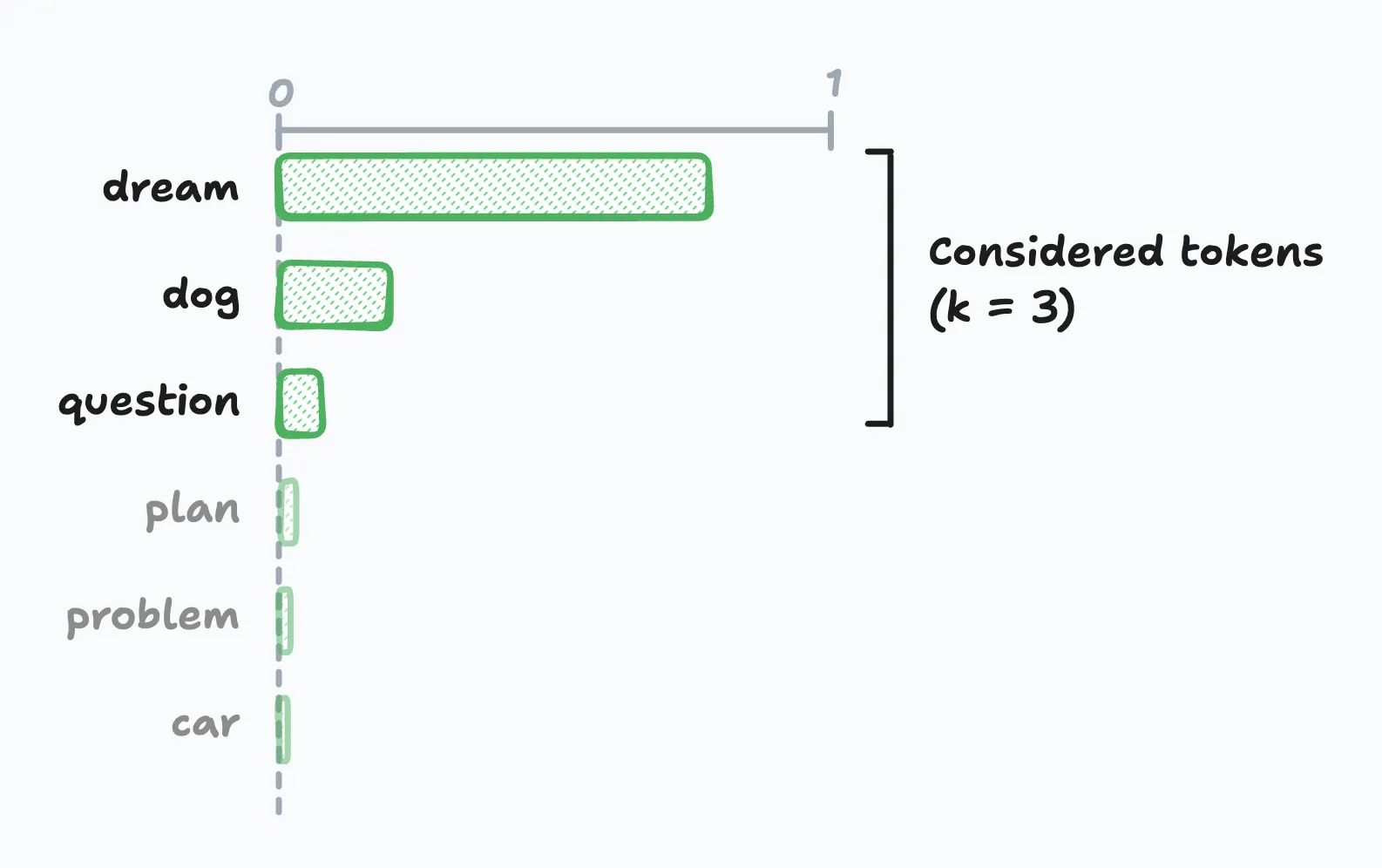How LLMs Generate Text for the Rest of Us
Ask the same question twice to any LLM and you’ll get two similar yet subtly different responses. As software engineers without formal ML backgrounds and with limited knowledge of neural networks, the underlying mechanics can feel like magic.
You’ve probably seen advice like “Use a low temperature to make the output deterministic” from one of those popular prompt engineering guides. This sounds like old family recipes passed down through generations of AI engineers.
But here’s the thing: it’s actually more straightforward than I originally expected!
This article should give you a solid intuition for how these models select tokens, and how parameters like temperature, top-k, and top-p influence the generated output. It doesn’t go into the inference details, so if you’re interested in the inner workings of the transformer architecture, sorry to disappoint; you can now close this tab.
To understand how these parameters work, we first need to understand the fundamentals of how LLMs generate text.
One token at a time…
Modern LLMs generate text one token at a time, using previously generated tokens as context for the next prediction. These are called autoregressive models. You can think of them as recursive functions that build results incrementally.

LLMs don’t directly manipulate raw text. Instead, LLMs operate on tokens, discrete units that can represent words, word fragments, or punctuation. They also encode special control sequences for tool calls or end-of-text markers. For example, the sentence "Hello world!" might be tokenized as ["Hello", " world", "!"], where each element represents a single token. Each token maps to a unique numerical identifier that the model can process.
Each model has a predefined set of tokens it understands, established during training. The set of all possible tokens is called the model’s vocabulary. Modern open-weight models (models whose weights are publicly available) like Llama 3 have vocabularies composed of 128K tokens, while closed-source models exceed 200K.
Now that we understand tokens, let’s examine how they flow through the generation process.
The Text Generation Pipeline
At a very high level, the LLM text generation pipeline breaks down into four distinct stages:

Stage 1 - Tokenization: The input text is converted into a token sequence. This step is fairly straightforward as it primarily consists of simple string manipulation and searching for the correct token in a lookup table.
Stage 2 - Inference: This is where the magic of the transformer architecture resides, and it’s where the heavy lifting occurs. Given an input sequence of tokens, the LLM’s core model computes a “score”—called a logit—for every possible next token in its entire vocabulary. Logits are raw numerical scores that represent the model’s confidence in each token; the higher the logit, the greater the likelihood of seeing that specific token next in the sequence.
Stage 3 - Decoding: Based on the logits generated in the inference step, a decoding algorithm selects the actual next token. This selection isn’t always about picking the most likely token; sometimes, a bit of controlled randomness is introduced to spark “creativity”.
Stage 4 - Detokenization: Once the next token is selected, it’s converted back into human-readable text. As its name indicates, it’s doing the reverse operation of the first stage.
A few key insights
Understanding this pipeline helped me clarify some misconceptions I had about how LLMs work. Here are the insights that clicked for me:
The inference stage doesn’t pick tokens, it scores them. I originally thought that the inference stage was in charge of selecting the next token, but that’s not the case in practice. The inference phase produces a logit for each token in its vocabulary. If the model has a vocabulary composed of 128K tokens, the output layer produces a vector of 128K real values. Conceptually, it’s like assigning a likelihood score to all possible words in the dictionary every time we want to complete a sentence. At this stage, all potential tokens are still considered; they’re just weighted with different scores.
Most of the process is deterministic. I find it fascinating that the vast majority of this generation process is mostly deterministic. Tokenization and detokenization are deterministic by design. But more surprisingly, given the same input sequence, the inference phase always produces the same logits. The randomness in text generation is introduced during the decoding phase.
You only have limited control over the decoding. As a developer, it’s important to understand what you have control over. Major hosted LLM providers only expose parameters that influence the token selection in the decoding phase. You have no control over the (de)tokenization process or the inference. All the creative parameters you can tweak affect how the final token is selected from those pre-computed scores.
With these fundamentals in place, let’s dive deeper into the decoding phase where all the interesting parameter tuning happens.
Decoding strategies
There are many ways to approach decoding. The most naive approach would be to always pick the most likely token each round. This approach is called greedy search. It turns out that the generated output is suboptimal. It’s quite repetitive because of its deterministic nature. This is the reason why conversational LLMs introduce some randomness in the token selection process.
This section contains some math equations, but bear with me. We’ll go over each concept step by step.
From Scores to Probabilities: The Softmax Function
Before we can select a token, we need to convert those raw logit scores into probabilities. During inference, the model outputs logits for every token in its vocabulary—values that can range anywhere from negative infinity to positive infinity. To make sense of these scores, we need to normalize them into a proper probability distribution where each value falls between 0 and 1, and all values sum to exactly 1.

The most straightforward approach would be simple division—take each logit score and divide it by the sum of all logits:
This seems reasonable, but it falls short in practice for two important reasons. First, it only works with positive values, yet logits can be negative. Second, this approach has an unintended side effect: it tends to flatten the probability distribution when logit values are large. Here’s what I mean:
| Logits | Simple Normalization |
|---|---|
[10, 11, 12] | [0.27, 0.33, 0.36] |
[100, 101, 102] | [0.33, 0.33, 0.34] |
To solve these problems, LLMs use the softmax function. It’s the standard normalization technique in machine learning and works similarly to simple division, but with a crucial twist that each logit is exponentiated before normalization:
Now let’s compare both approaches using our previous example:
| Logits | Simple Normalization | Softmax |
|---|---|---|
[10, 11, 12] | [0.27, 0.33, 0.36] | [0.09, 0.24, 0.67] |
[100, 101, 102] | [0.33, 0.33, 0.34] | [0.09, 0.24, 0.67] |
The softmax produces identical outputs for both rows, even though the logit values are completely different. This demonstrates the softmax function’s translation invariance. Shifting all values by the same amount doesn’t change the final probabilities.
More importantly, softmax preserves the relative differences between scores. It acts as a “soft argmax”, amplifying the highest-scoring tokens while still maintaining a valid probability distribution where all values sum to 1.
Now that we have proper probabilities, we can start controlling how tokens are selected. The first and most important parameter is temperature.
temperature: The Creativity Dial
Now we get to the fun part, controlling the output creativity! The magic of LLMs comes from occasionally selecting less likely tokens instead of always picking the most probable one. This behavior is controlled by the temperature parameter, which modifies our softmax function:
It is the same formula as softmax where each logit is divided by the temperature value T. Here’s how it works:
- T < 1 (Low temperature ❄️): Sharpens the probability distribution, making high-probability tokens even more likely. Output becomes more predictable and deterministic.
- T = 1 (Default): No modification to the probabilities. This is what most providers use as their baseline.
- T > 1 (High temperature 🔥): Flattens the probability distribution, giving lower-probability tokens a greater chance. Output becomes more creative and unpredictable. But be careful is the value is too high, the generated output might become non-sensical.

As temperature approaches zero, the model ends up always picking the most likely token, which is effectively equivalent to greedy search. While being entirely deterministic on paper, floating-point precision and implementation details can still introduce tiny variations.
Constraints on the temperature value vary between LLM providers. OpenAI and Google allow temperatures from 0 to 2, while Anthropic restricts it to 0 to 1. Interestingly, while most providers default to temperature 1, Ollama defaults to 0.8. On top of this, individual models can override these defaults through their Modelfile configuration.
While temperature gives you broad control over randomness, sometimes you need more precise filtering. That’s where top-k and top-p sampling come in.
top-k Sampling: Limiting the Playing Field
Sometimes even with temperature control, you want to completely eliminate unlikely tokens from consideration. That’s where top-k sampling comes in. It restricts token selection to only the K most probable tokens, effectively discarding the “long tail” of options that might produce less interesting output.

Here’s how it works: if k=3, the model can only choose from the three top tokens, ignoring all other possibilities regardless of their actual probabilities. The probability mass gets redistributed among these top-k tokens, and then the selection happens normally.
The challenge is finding the correct value for k. Set it too small, and you might discard good options when probabilities are evenly distributed. Set it too large, and you might include poor choices when probabilities are heavily skewed toward a few tokens.
Note: OpenAI’s API doesn’t expose top-k, but Google and Anthropic do.
top-p Sampling: Adaptive Token Selection
top-p sampling, also referred to as nucleus sampling in the literature, takes a different approach than top-k by using a cumulative probability threshold instead of a fixed number of tokens. The model selects from the smallest set of tokens whose cumulative probability exceeds the threshold p.

For example, if p=0.8, the model considers tokens until their cumulative probability reaches 80%, then selects from that set. This approach naturally adapts to different probability distributions.
When probabilities are uniform (spread out), it includes more tokens to reach the 80% threshold, and when probabilities are skewed (concentrated), it focuses on fewer, high-probability tokens.
Top-p values should be between 0 and 1, where 1 has no effect on sampling (includes all tokens). While its adaptive nature makes top-p often more practical than top-k for real-world applications, setting a correct p value requires trial and error.
Putting It All Together
Nothing prevents temperature, top-k, and top-p from being combined. They’re usually applied in the following order:
- Temperature scaling: Adjust the probability distribution
- Top-k and top-p filtering: Limit the candidate token set
- Renormalization: Ensure probabilities sum to 1 for the filtered set
- Random sampling: Select the final token using a random number generator
Practical Parameter Guidelines
Here are real-world examples of how to apply these parameters in practice. Remember that optimal values can vary between different models, so use these as starting points rather than absolute rules:
For Code Generation and Technical Writing:
- Temperature: 0.1-0.3 (low for consistency and correctness)
- Top-p: 0.8-0.9 (moderate filtering to maintain quality)
- Why this works: Code needs to be syntactically correct. The low temperature ensures the model only picks highly probable tokens, while moderate top-p filtering prevents obviously wrong choices.
For Creative Writing and Brainstorming:
- Temperature: 0.7-1.2 (higher for creativity and variety)
- Top-p: 0.9-0.95 (minimal filtering to preserve creative options)
- Why this works: Creative tasks benefit from unexpected word choices and novel combinations. Higher temperature encourages exploration of less common tokens while top-p prevents completely nonsensical outputs.
Keep It Simple
Start with temperature alone. While there are legitimate use cases for adjusting the top-k or and top-p, temperature often provides sufficient control for most applications.
Once you’ve found a temperature that works well for your use case, then consider whether additional filtering with top-k or top-p might help improve the generated output further.
Conclusion
The key insight is that LLMs are mostly deterministic machines. All the randomness and creativity you see comes entirely from the decoding step, not from the core model computation. Once you understand this, those cryptic parameters start making sense: temperature is your primary creativity dial (low for consistency, high for creativity), while top-k and top-p give additional control by filtering the candidate token set before selection.
Understanding these mechanics gives you better intuition for prompt engineering and helps you make informed decisions about when and how to adjust generation parameters for your specific use cases.
If you want to go deeper, many LLM providers expose the underlying probability distributions through logprobs parameters—this opens up creative possibilities for classification tasks, confidence scoring, and quality assessment. Check out OpenAI’s logprobs cookbook for practical examples of what’s possible when you peek under the hood.